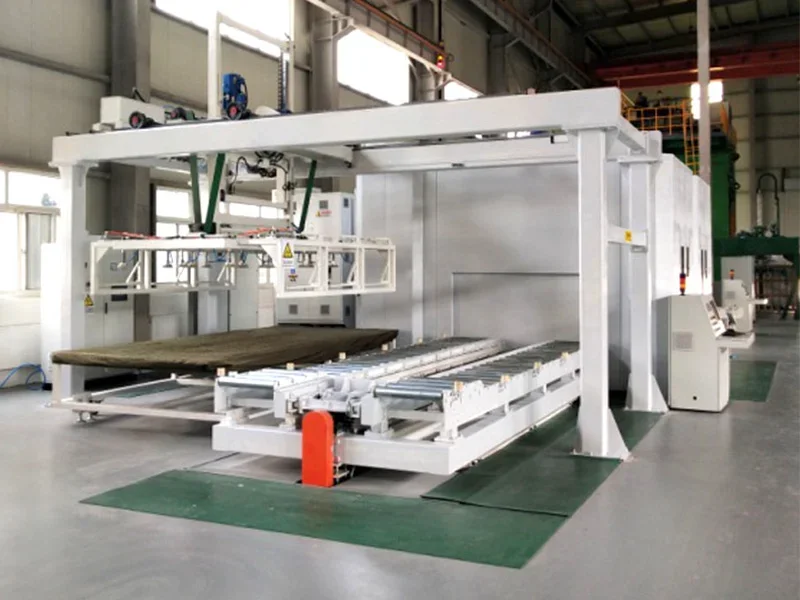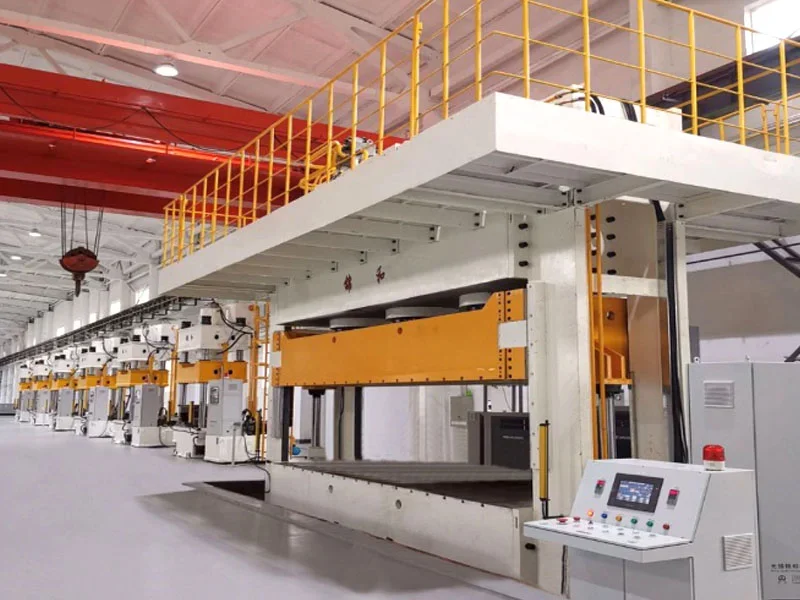In the realm of media and publishing, the composite press plays a pivotal role in delivering diverse content to audiences worldwide. This innovative form of press combines various materials to create unique and engaging publications that cater to a wide range of interests and preferences. From magazines to books, the composite press seamlessly integrates different elements to produce visually appealing and informative reading materials. Embracing modern technologies and creative approaches, composite press continues to evolve, captivating readers with its dynamic and interactive content delivery.
Understanding Composite Presses and Their Functionality
Specialized Machines
Composite presses are specialized machines used in manufacturing to shape and mold composite materials. These presses play a crucial role in the production process by applying heat and pressure to transform raw materials into finished composite products.
Composite presses come in various types, including hydraulic, electric, and pneumatic models, each offering unique features tailored to different manufacturing needs.
Customizable Functionality
The functionality of composite presses is customizable based on specific manufacturing requirements. Manufacturers can adjust the temperature, pressure levels, cycle times, and other parameters to achieve desired outcomes.
For example:
-
Adjusting the pressure settings allows for precise molding of intricate shapes.
-
Controlling temperature variations ensures uniform curing of composite materials.
Composite presses' customizable functionality enables manufacturers to produce a wide range of products with varying sizes, shapes, and material compositions efficiently.
Types and Sizes of Composite Presses in the Market
Variety of Press Types
Composite presses are available in various types, such as hydraulic, mechanical, and electric. Each type offers unique features catering to different production requirements. Hydraulic presses use fluid pressure for operation, mechanical presses utilize mechanisms like gears and levers, while electric presses rely on electrical power.
When choosing a composite press type, manufacturers consider factors like the materials being processed, desired output quality, and operational efficiency. For instance, hydraulic presses are preferred for applications requiring high force and precise control due to their ability to exert immense pressure evenly.
Range of Press Sizes
The sizes of composite presses vary significantly from small tabletop models suitable for laboratory testing to large industrial-scale machines capable of handling heavy-duty production tasks. Small tabletop composite presses are ideal for research and development purposes or small-scale production runs.
Industrial-scale composite presses are designed for mass production environments where high throughput is essential. These larger machines can accommodate bigger molds and handle a more extensive range of materials. The choice between press sizes depends on the volume of production, space availability, budget constraints, and specific application requirements.
Compression Molding vs. Composite Forming Presses
Process Variations
Compression molding presses use heat and pressure to shape composite materials, while composite forming presses employ techniques like vacuum bagging or resin transfer molding.
Composite forming presses offer flexibility in shaping composites through methods like thermoforming and resin infusion, ensuring intricate designs are achieved.
Advantages of Each
Compression molding is ideal for high-volume production due to its fast cycle times, making it suitable for mass-producing simple shapes such as flat panels.
On the other hand, composite forming presses are versatile and can produce complex shapes with varying thicknesses by utilizing techniques like pressure-assisted resin transfer molding.

Customization and Design Variations in Composite Presses
Custom Features
Composite presses offer customization options like multiple platens, various heating systems, and diverse control choices. Manufacturers provide the flexibility to tailor composite presses according to specific production needs. These custom features enhance efficiency and productivity in manufacturing processes.
Manufacturers can integrate heated platens into composite presses to facilitate uniform heating during the molding process. The incorporation of heated platens ensures consistent temperature distribution, resulting in high-quality finished products. This feature is crucial for industries requiring precise temperature control for optimal product performance.
Design Variations
Composite presses come in different design variations such as open-frame, closed-frame, or column-style structures. Each design variation serves a specific purpose based on the manufacturing requirements. For instance, open-frame composite presses offer accessibility from all sides, making them suitable for large-scale production lines where operators need easy access to the molds.
The choice between closed-frame and column-style composite presses depends on factors like space availability and structural stability requirements. Closed-frame designs provide rigidity and structural integrity needed for heavy-duty applications. On the other hand, column-style structures are ideal for applications requiring vertical force application during molding processes.
Tailored Solutions
Manufacturers understand that every industry has unique production demands; hence they offer tailored solutions through customizable features in composite presses. By providing a range of options such as bed sizes, tonnage capacities, and additional functionalities like vacuum systems or automated controls, manufacturers ensure that each composite press meets specific industry requirements.
-
Pros:
-
Enhanced efficiency through customized features.
-
Improved product quality with heated platens.
-
Flexibility to choose design variations based on needs.
-
-
Cons:
-
Cost may increase with added customizations.
-
Operational Aspects and Key Characteristics
Temperature Control
Composite presses rely on precise temperature control to ensure the quality of the final product. Maintaining the correct temperature during the pressing process is crucial for achieving desired material properties. For instance, carbon fiber composites often require specific curing temperatures to attain optimal strength.
Pressure Regulation
In composite press operations, uniform pressure distribution across the mold surface is essential for producing parts with consistent quality. Proper pressure regulation helps prevent defects such as voids or uneven material distribution within the composite structure. This ensures that each part meets stringent standards.
Control Systems
Advanced control systems integrated into composite presses allow operators to closely monitor and adjust various parameters in real-time. These systems provide insights into key metrics like temperature, pressure, and cycle times during pressing operations. With this capability, operators can make immediate adjustments to optimize production processes.
Efficient Energy Consumption
One of the key characteristics of composite presses is their ability to achieve efficient energy consumption. By utilizing modern technologies and optimized designs, these machines can reduce energy waste while maintaining high productivity levels. This not only benefits manufacturers by lowering operational costs but also contributes to environmental sustainability.
Fast Cycle Times
Composite presses are known for their fast cycle times, enabling manufacturers to increase production throughput significantly. Shorter cycle times mean quicker turnaround for parts manufacturing, which is crucial in meeting tight deadlines and fulfilling customer demands promptly.
Wide Range of Applications
Composite presses offer versatility in terms of applications due to their ability to work with various materials and part geometries. From aerospace components to automotive parts, these machines cater to a wide range of industries seeking lightweight yet durable solutions.
-
Precise temperature control ensures quality.
-
Uniform pressure distribution prevents defects.
-
Advanced control systems enable real-time monitoring.
-
Efficient energy consumption reduces operational costs.
-
Fast cycle times enhance production efficiency.
-
Versatility allows for a wide range of applications.

Automation and Precision in Composite Press Production
Robotics and PLCs
Automation technologies such as robotics and programmable logic controllers (PLCs) play a crucial role in enhancing productivity and precision in composite press production. By utilizing robotics, manufacturers can achieve consistent results by automating repetitive tasks. Programmable logic controllers ensure that every step of the manufacturing process is accurately controlled.
Robots can precisely position molds or tooling within the press, ensuring accurate alignment for the creation of flawless composite parts. These automated systems eliminate human error, leading to increased efficiency and reduced waste in production processes.
Automated Loading/Unloading Systems
Automated loading/unloading systems are essential components that streamline material handling processes within a composite press. These systems efficiently move raw materials into the press for processing and remove finished products once manufacturing is complete.
The integration of automated loading/unloading systems reduces manual labor requirements, significantly speeding up production cycles. This automation not only enhances efficiency but also ensures a safer working environment by minimizing human intervention in high-temperature settings.
Applications and Industries Utilizing Composite Presses
Diverse Applications
Composite presses are extensively used in a variety of industries due to their versatility. In the aerospace sector, they play a crucial role in crafting lightweight yet sturdy aircraft components like wings and fuselage parts. Similarly, in the automotive industry, composite presses are employed to fabricate durable and high-performance vehicle parts such as bumpers and interior panels.
The marine industry benefits from composite presses by utilizing them to create robust boat hulls that offer enhanced strength while being lightweight. Furthermore, in the realm of sporting goods, these presses are pivotal for manufacturing equipment like tennis rackets, golf club shafts, and bicycle frames. The ability of composite presses to cater to such diverse applications underscores their significance across various sectors.
Wide Range of Products
One of the primary advantages of using composite presses is their capability to produce a wide array of products efficiently. For instance, within the aerospace industry, these presses can manufacture intricate components with precision that meet stringent safety standards. In the automotive sector, composite presses contribute to creating parts that enhance fuel efficiency without compromising on durability.
Moreover, in marine applications, composite presses enable the production of boat hulls that offer superior performance characteristics compared to traditional materials like steel or aluminum.These presses facilitate the development of products that strike a balance between strength and agility for optimal athletic performance.
Materials Innovation
The utilization of advanced materials is integral to maximizing the potential of composite press technology across different industries. By incorporating cutting-edge materials like carbon fiber reinforced polymers (CFRP) or fiberglass composites into the manufacturing process using these presses ensures that end products possess exceptional strength-to-weight ratios.
Advancements in material science have led to increased customization options when using composite press technology. Manufacturers can now tailor material properties based on specific requirements for each application within aerospace, automotive, marine, or sporting goods sectors—highlighting how innovation in materials complements the capabilities offered by composite pressing techniques.
Selecting the Right Composite Press for Your Needs
Factors to Consider
When choosing a composite press, several factors play a crucial role. The first consideration is the production volume required for your manufacturing operations. Different presses are designed to handle varying production capacities, so it's essential to match your needs with the press's capabilities. Secondly, the material type being processed is vital. Some composite presses are better suited for specific materials like carbon fiber or fiberglass. Lastly, desired end product specifications must be taken into account as different presses offer varying levels of precision and customization.
Considering these factors ensures that you select a composite press that aligns with your production requirements and material characteristics. For instance, if you need high precision in producing aerospace components using carbon fiber materials, you would opt for a specialized composite press tailored for such applications.
Budget and Scalability
Another critical aspect to evaluate when choosing a composite press is your available budget and future scalability needs. Assessing how much you can invest in a press upfront will help narrow down options within your financial constraints while still meeting operational demands. Considering future scalability is essential to ensure that the chosen press can accommodate potential growth in production volumes or diversification of product lines.
Making informed decisions about budget allocation and scalability prevents unnecessary financial strain and equipment limitations down the line. For example, investing in an expandable composite press that allows for modular upgrades can support business expansion without requiring significant additional investments.
Expert Consultation
Seeking advice from experts or manufacturers can provide valuable insights into selecting the most suitable composite press for your specific manufacturing needs. These professionals have in-depth knowledge of various presses available on the market and can offer guidance based on their expertise and experience working with similar industries or applications.
Consulting with experts helps leverage their industry insights to make well-informed decisions regarding composite press selection. For instance, receiving recommendations from experienced manufacturers may lead to discovering innovative solutions or features that could enhance production efficiency within your facility.

Final Remarks
In conclusion, the diverse landscape of composite presses offers a myriad of options tailored to specific manufacturing needs. Understanding the functionality, types, sizes, and operational aspects of these presses is crucial for industries seeking precision and efficiency in composite production. Customization and design variations further enhance the adaptability of composite presses across various applications and sectors. Automation plays a pivotal role in streamlining processes and ensuring consistent results, while the selection process demands a thorough assessment to match the right press with individual requirements.
For those navigating the realm of composite press machinery, conducting in-depth research and consulting industry experts are imperative steps towards informed decision-making. By leveraging the insights provided in this comprehensive guide, businesses can optimize their production processes, enhance product quality, and stay competitive in today's dynamic market environment.
Frequently Asked Questions
What are composite presses used for?
Composite presses are primarily used in manufacturing processes to create composite materials by applying heat and pressure to mold various components together efficiently.
How do compression molding and composite forming presses differ?
Compression molding involves preheating materials before placing them in the mold, while composite forming presses use a combination of heat and pressure during the entire process without preheating.
Can customization be done on composite presses?
Yes, manufacturers offer customization options for composite presses, allowing clients to tailor features such as size, shape, heating methods, and control systems according to specific requirements.
What industries benefit from utilizing composite presses?
Industries like aerospace, automotive, marine, sports equipment manufacturing, and renewable energy sectors extensively utilize composite presses due to their ability to produce high-strength lightweight components efficiently.
How crucial is precision in composite press production?
Precision plays a vital role in ensuring the quality and consistency of the final products manufactured using composite presses. Automation technologies help achieve precise control over parameters like temperature and pressure during production.
